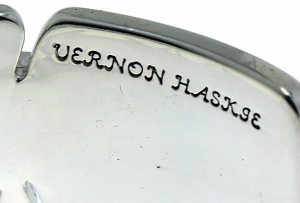Vernon Haskie
INTRODUCTION
When you meet Navajo artist Vernon Haskie you don’t get the feeling that you are talking to one of the greatest Native American artists of his generation. Art is not his only passion and he feels very comfortable talking about cars, guns, biology, or whatever topic comes up. Like his art, this is a genuine human being that you will never forget meeting.
HALLMARK
Vernon Haskie
1990 to Present

TRIBE:
Navajo
STYLE:
Heavy silver or gold, deep channel inlay, lots of coral
FIRST YEAR MAKING ART:
1984





